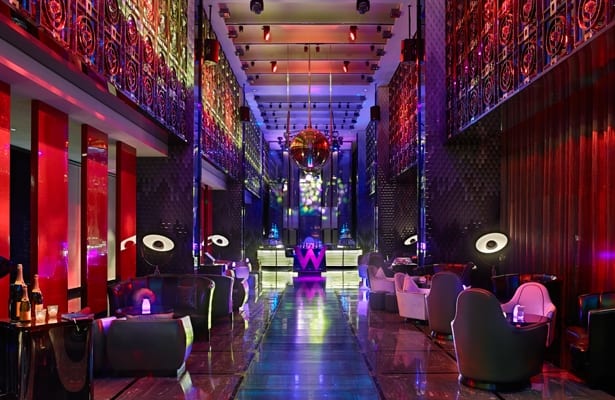 ||
||
 “Our brief was to integrate Beijing’s rich history with its pulsating modern vibe”An ancient Chinese maxim goes head-to-head with maximalist design at the new W hotel in China’s capital. “Our brief was to integrate Beijing’s rich history with its pulsating modern vibe,” explains the hotel’s designer, Ed Ng of AB Concept.
“Our brief was to integrate Beijing’s rich history with its pulsating modern vibe”An ancient Chinese maxim goes head-to-head with maximalist design at the new W hotel in China’s capital. “Our brief was to integrate Beijing’s rich history with its pulsating modern vibe,” explains the hotel’s designer, Ed Ng of AB Concept.
For many elements of the interior, the studio took as a starting point the Chinese philosophical concept of tian yuan di fang, which defines heaven as round and the Earth as square. For example, the feature walls in the lobby are adorned with round and square patterns, while a dramatic artwork made from multiple Ming plates hangs behind the reception desk.
In the Yen restaurant on the second floor, the same style of ceramics are used as a decorative motif, complementing the blue and white colour scheme. Artworks depicting different areas of China reinforce the theme of national identity while the modern styling of the leather chairs is juxtaposed by the traditional Chinese knots found in the chairbacks.
This mix of old and new even continues into the bedrooms, with cushions inspired by patterns on Ming porcelain, round bathtubs and headboards showing the silhouette of Chinese female soldiers on parade during the National China Day festival. The rooms also feature full-length windows offering views of the city’s historic monuments.
With offices in Bangkok, Taipei and Hong Kong, AB Concept has chalked up a number of high-end hotel chains since Ng launched the design studio together with Terence Ngan in 1999; its clients include Four Seasons, Mandarin Oriental and Shangri-La.
 The circle-within- a-square motif refers to an ancient Chinese concept
The circle-within- a-square motif refers to an ancient Chinese concept
“We always had a great relationship with [W’s parent company] Starwood,” says Ng. “When they planned to bring the first W hotel to Beijing, they naturally brought us on board, especially after our first successful ‘marriage’ with W Bali.”
 The hotel bar features an actual catwalkAs the W brand aligns itself closely with fashion, film and music, so there are design-led nods to these creative industries throughout this Beijing outpost. The hotel bar features an actual catwalk while the lighting, custom-designed by AB Concept, is intended mimic the lights found on film sets.Further along the bar area, there is even a ‘DJ ball’ which is suspended by day and opens up at night to reveal a DJ booth.
The hotel bar features an actual catwalkAs the W brand aligns itself closely with fashion, film and music, so there are design-led nods to these creative industries throughout this Beijing outpost. The hotel bar features an actual catwalk while the lighting, custom-designed by AB Concept, is intended mimic the lights found on film sets.Further along the bar area, there is even a ‘DJ ball’ which is suspended by day and opens up at night to reveal a DJ booth.
In the all-day-dining restaurant, there is a literal interpretation of the culinary theme with a depiction of dumplings adorning a brick wall of the main dining area, and small dumpling-shaped features in gold to match. The dining tables here are shaped like grains of rice, clustered together. If the restaurant itself is intended to be a ‘food laboratory’, then the entrance, with its bookshelves and bookcases forming a spiral shape, is its complementary ‘research area’.
Ng says of the W Lounge, the cinematically lit main bar: “Structurally, it’s is a very interesting space. There is an ultra-exclusive VIP area, right at the back of the bar. You step up to the mezzanine floor and from there you can see down into the whole lounge – but nobody can see you.”
There is also another, smaller VIP room in the lounge. Ng describes how “the whole room is like a gigantic bird’s nest; you are enclosed in this opulent space.”
 In the spa, the look is dialled down a notch to soothe
In the spa, the look is dialled down a notch to soothe
The colours used in each part of the hotel are reflective of the purpose of the room; the spa’s yellow The all-day-dining restaurant, a ‘food laboratory’ hue references the honey-based treatments on offer; for instance. “My favourite is the magnificent chandelier in the lobby, made up of 26,000 lights with ever-changing colours,” says Ng.
The all-day-dining restaurant, a ‘food laboratory’ hue references the honey-based treatments on offer; for instance. “My favourite is the magnificent chandelier in the lobby, made up of 26,000 lights with ever-changing colours,” says Ng.
Summing up the scheme, he says finally: “The interior will surprise people who have been to Beijing before, as they will discover a modern and sexy side to the city.”
The design of W hotel Beijing mixes traditional Chinese motifs with some of the eccentricities we’ve come to expect from the brand























